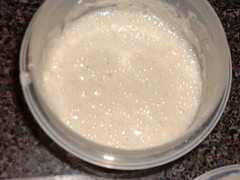
I've been baking bread since I was eight years old. My first loaf was over kneaded, under mixed and turned out flat and hard like a hockey puck but I persevered and pretty soon, I was baking all the bread for the family. My mother swears she doesn't know why but yeast and I have always had a symbiotic relationship. Given all that kneading time under my belt, you would have thought that sourdough bread would be a natural. You would be very wrong. I've only been baking sourdough breads for about four years and that isn't a very long time in the sourdough game. I know one sourdough baker who has been baking for over 30 years and who uses a starter that has been in his family for 80 years. Now, that is a long time!
My relationship with the finicky yeast creatures that are sourdough starters goes back a lot further than four years. About 15 years ago when I was living in Peoria, Il for a brief stint, I decided to amuse myself by trying to bake with a mail order starter (believe me, there isn't anything else to do in Peoria). It was a disaster. Within four weeks I had not only killed the starter but I had a gelatinous pink and brown streaky mess in a container on my counter that caused my landlord to think something or somebody had died in my apartment.
When I moved to Boston a few months later, I decided to give sourdough another try and failed again. This time, I tried using a friend's starter. I didn't kill it but it never quite worked the way sourdough starters are suppose to work. My next failure was when I tried to grow a starter from scratch right after MBH and I had moved in together. He lived in a sterile highrise apartment building and there were no good wild yeasties to be found. All we captured was mold in the Ball jar and while he thought that was pretty cool, I couldn't bake bread with it. But, when we moved into a house that was almost 100 years old I decided to give sourdough starter once last try. After all, a house that old had to have some good stuff flying through the air! Now, four years later, I have a collection of three happy, frothy and healthy starters: one rye, one wheat, and one good ole unbleached all purpose flour.
A little starter history now before we get to the recipe portion of our show. A sourdough starter is an equal mixture of water and flour that has been invaded by varieties of lactobacillius and wild yeast. San Francisco Sourdough gets it flavour from a very particular lactobacillius called lactobacillus sanfrancisco. Rye flour works the best to start the growth of wild yeast but there are recipes for getting starters from wheat flour and grapes. Once you have a starter thriving it must be fed daily. About 2 or three hours after "they" have eaten, a mildly alcoholic liquid will form on top of the mixture. This is called "hooch" and this is where we get the term for bad, cheap booze! It originated from the Alaskan Gold Rush when the Rushers would drink the hooch from their sourdough starters when they couldn't get alcohol any other place.
Once a starter gets very established it can be stored in the fridge between times of baking and it doesn't require daily feeding until you are ready to bake with the starter. Then, it takes about two or three days of steady feeding and you will be ready to bake! Baking with starters takes almost three times longer than with active yeast because the yeast in starter is slow to rise vs the fast acting commercial yeasts.
The starter in the picture above is my all purpose starter. I haven't baked with it in almost 4 months and haven't fed it in about 2 months but it sure is a good and established creature! I pulled it out of the fridge on Sunday, fed it twice on Sunday, Monday and this morning gave it a super feeding (1 cup water/1 cup flour). About 2 hours ago, I started the dough for my Sourdough Sweet Rolls. I'm taking them into work on Thursday and the dough has to rise all night tonight. Tomorrow morning, I'll get up about an hour earlier than normal, roll out the dough, fill it with the cinnamon and sugar mixture, slice the rolls out and it will rise all day on the counter while I am at work. Tomorrow night I'll bake them and frost them the following morning just in time to take them to work. Tomorrow night, I'll also start MBH's Sourdough boule by using the toss off starter from tonight. Toss off is the starter you throw away during the feeding process .
There's gonna be a whole lotta bakin' goin' on here the next few nights...
Sourdough Starter Recipe
Never use metal to stir or store starter, the metal will react with the starter
1 Cup organic rye flour
1 Cup water (filtered or bottled water)
Place in a plastic container or a glass large mouth canning jar, mix with a wooden spoon and leave exposed to the air. (you can use cheese cloth if you are overly concerned about "things" besides wild yeast and sourdough bacteria falling into the starter). Every day feed the starter.To feed a starter, stir back into the starter any hooch. Then throw away or "toss off" about half the mixture. Using cool not hot water, feed the starter with an equal part of water and flour (I use 1/2 cup of water and 1/2 cup of flour). Keep this up for about 5-7 days. After this time, you should notice little bubbles of gas and the starter should have an acidic smell to it (vinegar and/or gym socks is pretty normal). Once this happens, you have an active starter and you are ready to bake!
(Note: if you want your starter to become a wheat or all purpose starter, start feeding it with the flour of your choice AFTER you have it established. About 4 or 5 feeding cycles into the life of the starter you will have the starter your want).
There are some super resources on the internet for sourdough baking, one of the best is Mike Avery's excellent Sourdough Home (linked under "Who Breadchick is reading") and if you want to try your hand at baking with sourdough without having to grow the little yeast beasties yourself, you can send away for a free sample of excellent starter at Carl's Friend's. Good Luck!
Follow Up on 1/11: I received an email about this post with a really good question about getting a starter going: Do you need to use rye flour for all the feedings during the first week?
I should have been more clear about this, you don't have to use rye flour for the feedings during the first week. I typically use a mixture of rye and all purpose for the first week and then all subsequent feedings for my rye starter. If you use all rye, you will notice a very dark and wet starter but this is great for dark ryes and those hearty German rye breads!







